Explore My Workshops
Welcome to my portfolio! Here you will find a curated selection of workshops completed throughout the CTL5011 course. These workshops showcase my skills and learning experiences throughout this course. Explore the diverse range of work I have created, reflecting my interests in technology and creativity.
Workshop 1- Graphic Comic

The term “smartphone zombie” describes someone who is so focused on their phone that they stop paying attention to what’s going on around them. It’s a funny term, but also a bit serious, because it shows how technology can affect the way we move through the world. Instead of being present or noticing others, we sometimes get completely pulled into our screens, like zombies. In the comic strip, this idea is shown through a simple but relatable scene. A person is walking while staring at their phone and ends up walking straight into a fire hydrant. Even after the bump, they’re still stuck on their screen. Meanwhile, the person is more socially aware of their surroundings and is aware of what happens when you become fixated on your phone, you become a zombie. This comic made me think about how easy it is to get caught up in our phones. We scroll without realizing how much time we’ve lost or how we might be missing out on real-life moments. The message isn’t to stop using phones completely, but to be more aware of when it’s time to unplug and look up.
One thing that stood out to me about this source was the dangers of distracted walking/driving by using your phone. In 2021, more than 7,000 pedestrians were killed and 60,000 injured in the United States as a result of distracted walking, according to The National Highway Traffic Safety Administration (Slon, 2023). https://www.saturdayeveningpost.com/2023/10/the-rise-of-the-smart-phone-zombies/
Workshop 2- Historical Storytelling
Creating this video about my Nonno’s life story was a meaningful and emotional experience. Sharing how he met my Nonna Maria allowed me to connect more deeply with my family’s history and appreciate the power of love, even during the most difficult times. During World War II, my Nonno served as a soldier and participated in a letter-writing program that connected him with my Nonna, Maria, a woman from Italy. Through their letters, they built a bond that grew stronger despite the distance and uncertainty of war. It’s incredible to think that a simple exchange of words on paper led to a lifetime of love and family.
Growing up, I never heard too many stories from my Nonno. He only speaks Italian and I only know a few simple phrases and words in Italian. This has always made it very difficult to communicate. This is one of the stories that I will always remember as it is one of the few stories I have gotten the chance to hear. This project gave me a new appreciation for the sacrifices and experiences of past generations. I feel proud to carry their story forward and hope that by sharing it, others can also reflect on the importance of connection, resilience, and love.
To view my video, follow the link: https://express.adobe.com/id/urn:aaid:sc:US:ec2e7ea3-220b-5e8e-8227-384003a6eea2?invite=true&accept=true&promoid=Z2G1FQKR&mv=other
Workshop 3- Visual Diary
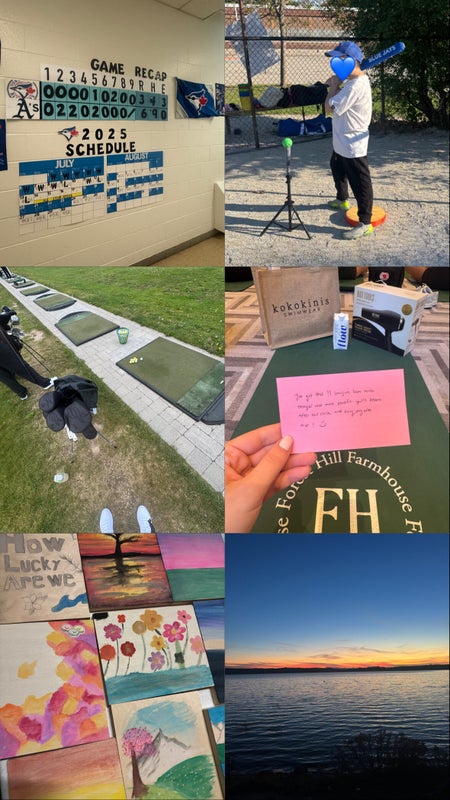
During challenging times, I find inner peace through self-care and meaningful activities. After the pandemic, I struggled with loneliness as my daily interactions with friends and family suddenly stopped. To cope, I began exploring independent hobbies that helped me feel grounded.
One of the first was golf. I started playing about three years ago and love that it’s something I can do entirely on my own. Whether at the driving range or on the course, it gives me space to relax and feel motivated towards my personal growth. I also turned to fitness. Working out alone helps clear my mind and boosts both my physical and mental health. I also started attending group classes where I connected to so many women who shared a similar interest as me.
Another source of peace is coaching baseball. Through my work with Jays Care Foundation, I started a Challenger Baseball league in my community. Challenger Baseball is an adaptive program for children with physical and cognitive disabilities. This has brought me deep joy and connection. Seeing the kids grow and have fun is truly the highlight of my summer.
Lastly, I find peace in nature and creativity. Time by the water and engaging with art help me disconnect from technology and reconnect with the world around me. These moments remind me to slow down and be present.
Workshop 4- Green Screen Advertisement
My advertisement for Banana Boat sunscreen for kids uses emotional techniques to connect with the audience, particularly parents and caregivers. The image of a happy child running freely at the beach evokes feelings of joy, and innocence. This scene creates a sense of warmth and safety, encouraging viewers to associate those emotions with the product. By portraying a child enjoying the outdoors, the advertisement taps into parental interests to protect their children while still allowing them to have fun in the sun.
The slogan, "gentle protection for sensitive skin," enhances the emotional appeal. It reassures parents/guardians that this product is safe and specially designed for their child's delicate skin. Words like "gentle" and "sensitive" evoke feelings of care, love, and protection. These emotional triggers help build trust in the brand and its commitment to children.
Overall, the ad combines visual imagery and carefully chosen words to appeal to a parent and guardian’s natural instinct to protect their children. It positions Banana Boat not just as a sunscreen, but as a partner in supporting kids’ fun and health during outdoor activities in the sun. This emotional approach makes the advertisement both memorable and persuasive.
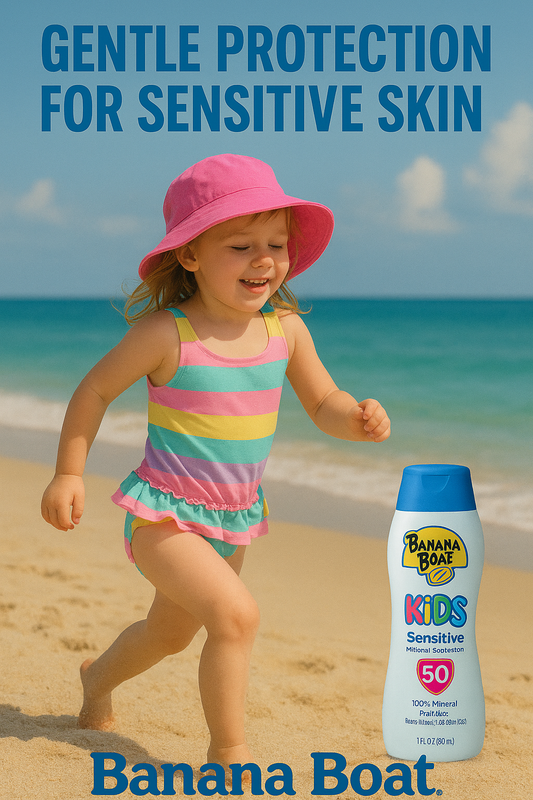
Workshop 5- Coded Game
Creating my own version of Flappy Bird was my first real experience with coding a video game, and it really brought Papert’s constructionism to life for me. Instead of just learning about how games work, I got to build one myself. The hands-on nature of the project helped me understand coding concepts in a very engaging way.
What made the experience even better were the detailed instructions that guided me through the process. They made the learning feel approachable and fun, not overwhelming. That trial-and-error process helped me learn by doing, which is exactly what Papert emphasized in his theory.
What is also important is that the game can be shared and discussed with others, which adds a social layer to the learning. That kind of collaboration and reflection is a big part of constructionist learning. Overall, the activity gives learners the chance to take charge of their own learning journey, build something real, and learn in a way that sticks.
You can find my Coded Game here: https://studio.code.org/c/2631842596
Workshop 6- Mind Map
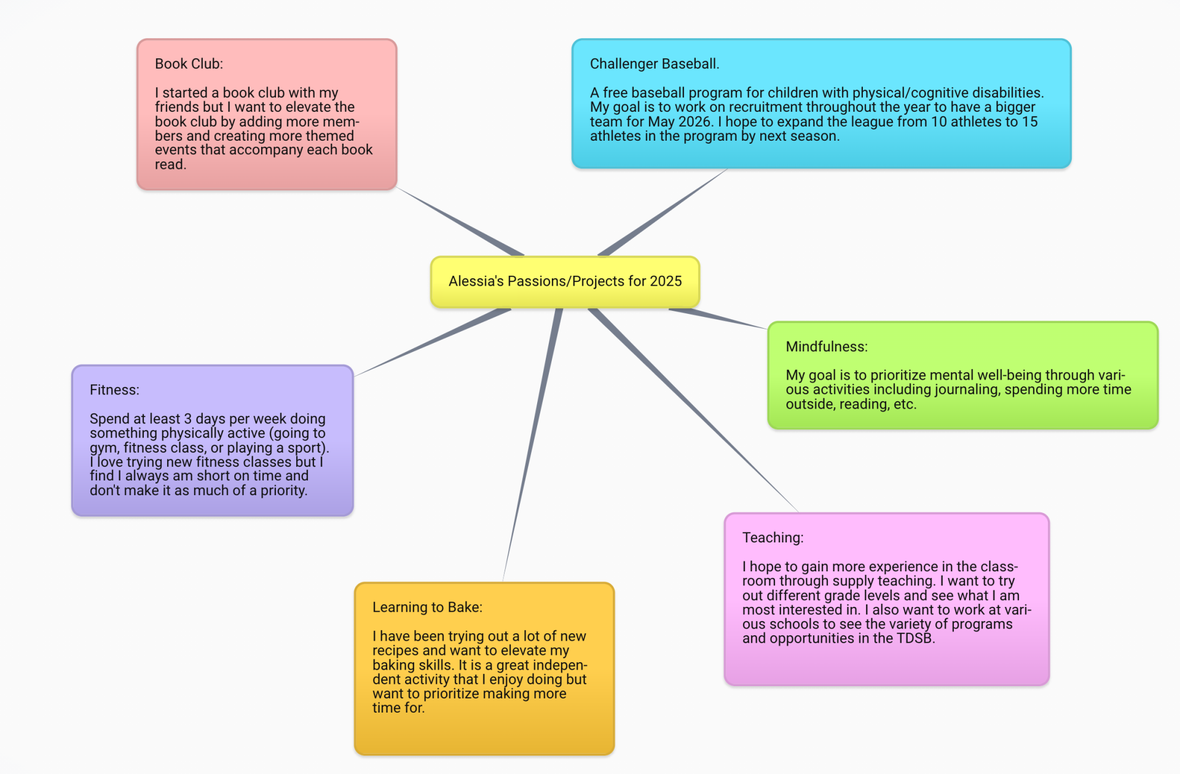
My mind map supports deeper learning by helping me organize my passions and goals in a way that is both visual and meaningful. Each project is something I genuinely care about, and mapping them out like this allows me to reflect on what I want to achieve and how I can achieve it. It encourages me to think more deeply about why each goal matters and how I will grow from pursuing it.
For example, when I plan themed events for my book club or recruit athletes for Challenger Baseball, I’m setting intentional, creative targets. These experiences help me build skills like communication, leadership, and empathy. My focus on mindfulness and fitness is not just about routines, it is about prioritizing my well-being so I can be present in everything else I do. Even baking becomes a space for independent exploration and practice.
Through this mind map, I can connect different areas of my life. It helps me stay motivated, accountable, and creates a space for me to have deeper learning and understanding of my interests.
Workshop 7- QR Story
For my story, I selected my TV remote, and I honestly believe my remote would hate me, so here is my short story of how grumpy I would imagine them to be.
Short Story:
Hello, it's me, the TV Remote, the only thing in this house that should have an ounce of authority, and yet I am treated like forgotten leftovers in the back of the fridge. I remember a time when I was respected. Held with care. Pointed with purpose. Now? I spend half my day wedged between couch cushions next to stale popcorn and Leo's dog fur.
Nobody looks for me properly. Everyone just goes around the house yelling, “Where’s the remote?!” like I have disappeared and found a new family in another house. Newsflash: I am right where you left me last night when you sat on me. Again.
I get held by sticky fingers, dropped while Alessia reaches for snacks, and left buried in between what feels like hundreds of pillows and blankets. Why does she even need that many! And don’t get me started on my batteries. One day I’m powering through Netflix and The Bachelor, next thing I know, they’re yanking my life source out to stick some old batteries in me that used to belong to a flashlight. Considering how important do I deserve some old flashlight batteries? No, I deserve fresh batteries.
I’ve seen it all. Endless reality shows, dramatic news meltdowns, a documentary about McDonald's. Most of the time, the TV just gets left on for the dog to watch while they are out at work. Talk about a waste of resources, Leo doesn't even like watching the Food Network.
But I carry on, because without me, Alessia would be stuck watching some boring documentaries, unable to change the channel to what she really wants to watch. And honestly? Maybe once in a while, she would deserve it.
Make sure to check out the QR code to hear the audio!
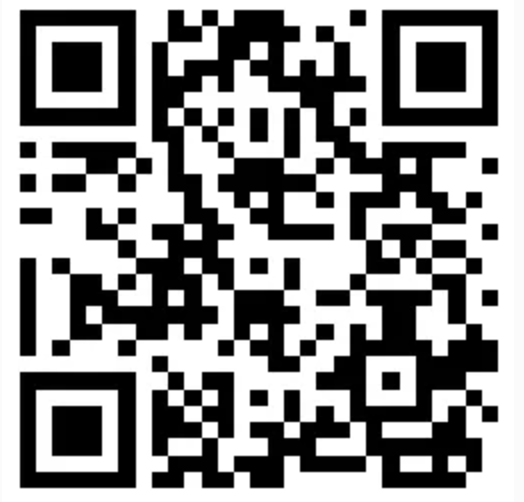
Workshop 8- Free Choice
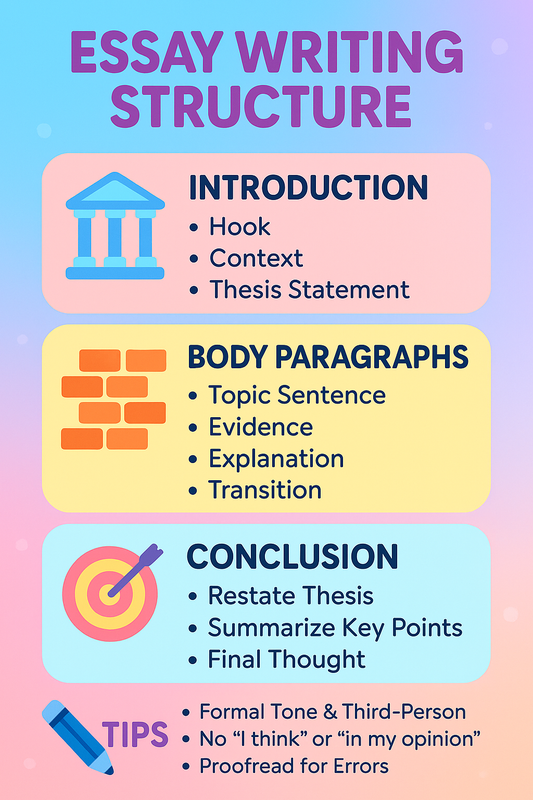
For this task, I wanted to experiment with using artificial intelligence to create visually engaging classroom posters. As a high school teacher with a teachable focus in English and Social Sciences, I’ve always been passionate about the role of classroom spaces in supporting learning. I believe that thoughtfully designed environments can inspire curiosity and creativity.
My goal was to explore how technology, specifically AI, can be used as a tool to help educators build meaningful visual aids. I chose to design an infographic poster focused on essay writing structure, a key skill in both English and Social Science classrooms. I was interested in how AI could help generate something that was not only functional but also appealing to high school students.
Using AI to assist in the creation of this classroom tool was efficient. It allowed me to test visual layouts without having to rely on advanced graphic design skills. I see real potential in using this technology to create educational materials. I look forward to continuing to learning and experiment with these tools more and how it can impact my teaching practice.
Create Your Own Website With Webador